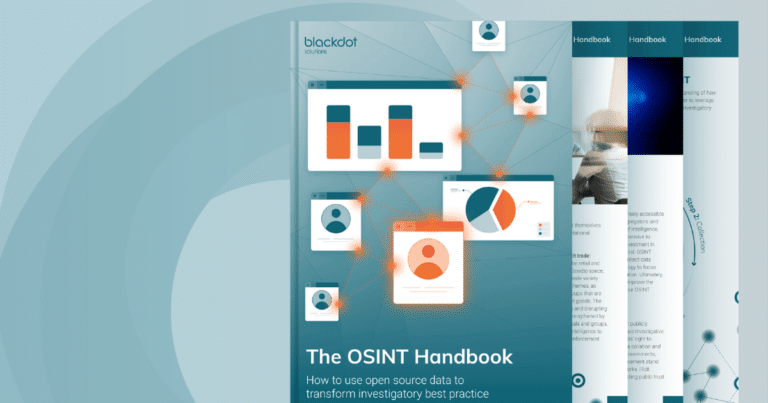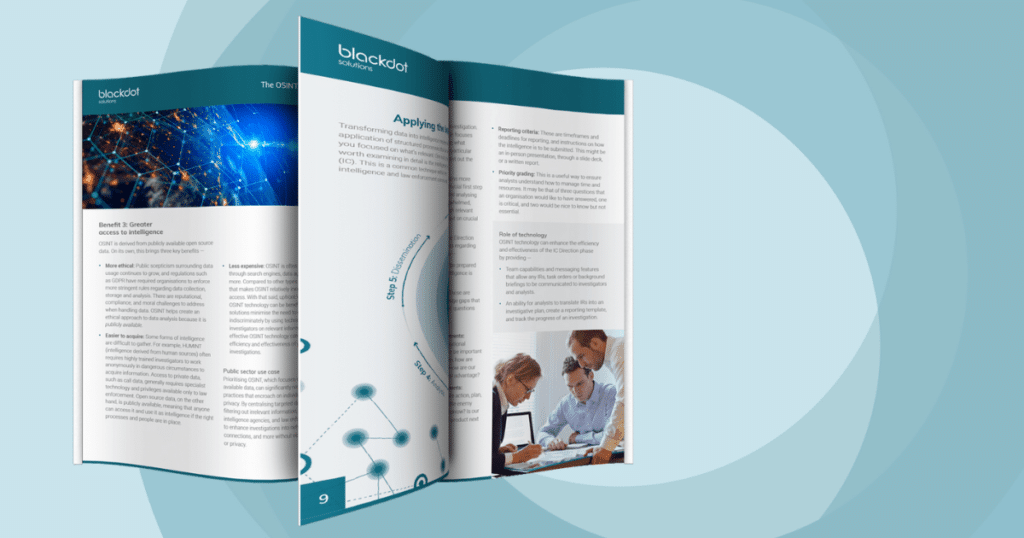Introducing the OSINT Handbook: the Comprehensive Guide to OSINT Investigations

Who Should Read the OSINT Handbook?
Whether you’re a seasoned OSINT investigator or just starting out, the OSINT Handbook is a crucial resource for anyone wanting to get the most out of OSINT. It contains actionable insights on how to ensure you’re implementing best practices and making effective use of this valuable technique.
Although different sectors use OSINT to solve different problems, best practices apply to all investigators regardless of industry. That’s why we’ve written this Handbook with OSINT investigators from all industries in mind. So, if you’re an OSINT investigator working in Banking, Government, Law Enforcement, or a different industry entirely, the OSINT Handbook is for you.
Plus, we’ve made sure to include industry-specific examples and use cases to contextualise the advice included in the OSINT Handbook to ensure that you can start using these insights to lead better investigations as soon as possible.
Read on to learn more about this vital resource and claim your free copy today.

Why Should You be Using OSINT?
Data has come to define the modern world. It enables more accurate decision-making and deeper investigations. However, the sheer volume of data that exists can confuse and overwhelm analysis. Dependable and secure solutions are required to overcome issues associated with the variable reliability of sources, and the disaggregated and siloed way in which data must often be accessed. Using data to drive decision-making is a central challenge and opportunity for businesses and governments alike.
Some data is privately protected, but a large percentage of data is publicly available. Public data (or “open source” data) is there for anyone to use, but it can be difficult to identify the relevant information at the right time. OSINT (Open Source Intelligence) is the application of intelligence-led processes to transform OSD (Open Source Data) into actionable insights.
OSINT is a military intelligence term, and remains a staple technique in counter-terrorism, counter-intelligence and organised crime investigations. However, the potential and wide-reaching nature of OSINT has driven an expansion out of military and government applications into the private sector.
The OSINT market is expected to reach nearly $12bn (£8.5bn) by 2026, registering a CAGR of 17.4%. With an increased focus on intelligence-led data analysis (aligned with Big Data trends more generally), OSINT is transforming investigatory best practice and creating far more robust outcomes across other use cases and industries, including:
- Fraud investigations
- Brand protection
- Insider threat identification
- Illicit trade investigations
- Due diligence
Furthermore, we expect to see OSINT become an increasingly important part of compliance, particularly in financial services. As a result, leveraging the potential of open source data is a critical investment in the future.

What’s in the OSINT Handbook?
We’ve curated the OSINT handbook to help you build an OSINT framework that leverages technology and process best practices in order to enhance your investigative and decision-making capabilities. Fundamentally, our goal is to empower you to lead OSINT investigations that are more ethical, accurate and effective.
Below are just some of the insights you can gain by claiming your free copy today.
Understanding the value of OSINT
If you’re new to OSINT or wondering if there are more ways it could contribute to your existing investigations, you might not be aware of the wide variety of benefits this technique brings to a broad range of use cases. From expanded insights to lower costs, the OSINT Handbook explains the key benefits organisations gain when using OSINT effectively. It contains examples specific to use cases across financial services, corporate investigations, Government agencies, law enforcement and risk agencies, so you can better understand the value OSINT could bring to your organisation.
Implementing OSINT effectively within your organisation
The OSINT Handbook explains how investigators can overcome common challenges to use this technique more effectively. It contains valuable insights regarding OSINT best practices and how to optimise the effectiveness of OSINT at each stage of the intelligence cycle.
Finding the right OSINT tool
Whilst it is possible to conduct OSINT with minimal assistance from technology, using the right OSINT tools leads to greater effectiveness and accuracy. The OSINT Handbook explains the crucial role technology can play at each stage of an OSINT investigation, from reducing manual tasks to increasing efficiency.
Each organisation has unique technology requirements, and it’s important to gain a full understanding of these when picking an OSINT tool. In the Handbook, we talk you through the different considerations you’ll need to make and features to look for in order to find the tool that’s right for you. OSINT tools should assist, not replace, the investigator, empowering them to spend more time conducting important analysis and drawing meaningful insights.
Ensuring ethical investigations
OSINT is drawn from publicly available data, meaning that it is often more ethical than other forms of investigation. However, you shouldn’t rely on this fact alone to ensure ethical investigations. Read the OSINT Handbook to learn how you can ensure your investigations remain as ethical as possible.
Download the OSINT Handbook Now
Don’t fall behind – claim your free copy of the OSINT Handbook and start leading more effective, faster investigations today.



